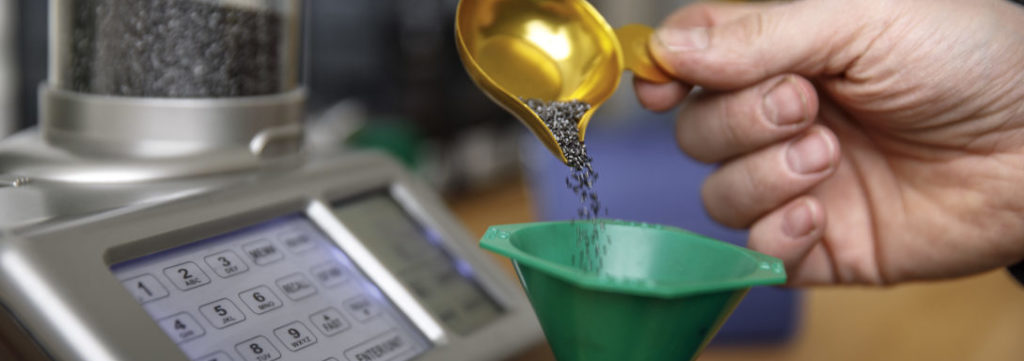
The reloading process – how to reload
“I want to reload my own ammo – where do I start?”
If you are fairly new to reloading your own ammunition, it’s really important that you have the reloading process under control. Here, we’ve created a simple reloading guide for anyone wanting to learn the basics of handloading.
Important reloading tip: know your brass!
Use only cases with known origin for reloading. This means using brass you’ve shot yourself or new cases sold as components. These are always the most reliable choice. All cases have to be checked thoroughly before the reloading process for possible damages.
How to reload ammunition – a step by step guide
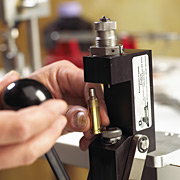 1. Depriming the brass
1. Depriming the brass
The primer is removed through the hole in the middle of the case primer pocket with a suitable tool. The easiest way to deprime brass is to use a reloading press. Depriming can also be done when sizing.
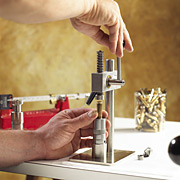 2. Resizing the case neck
2. Resizing the case neck
When you are planning to use a cartridge again with the same firearm, resizing only the case neck is an adequate procedure. This reduces the strain on the case compared to full resizing of the case. The case neck is resized to its original dimensions with an appropriate collar. Remember lubrication.
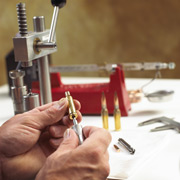 3. Cleaning the primer pocket
3. Cleaning the primer pocket
Clean the primer pocket from all shooting deposit. At the same time it is good to visually check that the case primer pocket has not expanded due to pressure.
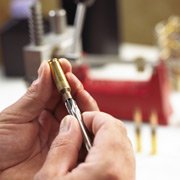 4. Belling the case mouth
4. Belling the case mouth
Also clean the case mouth. The case mouth is belled, i.e. expanded, slightly to enable the bullet heel to enter the case mouth using finger pressure.
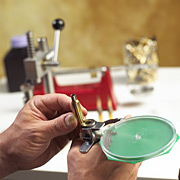 5. Priming the case
5. Priming the case
The priming can be done with a hand tool or a bench tool. All case lubrication oils have to be cleaned off before priming the brass. A major benefit of hand-held priming tools is the ability to feel the primer touching the bottom of the case pocket, giving more consistent and even seating of the primer. Also, it makes it easier to detect an expanded primer pocket. Use protective eye wear when priming.
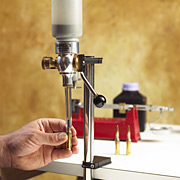 6. Charging the case
6. Charging the case
The powder charge is poured into the case with a powder funnel. It is important to check the charge with a reliable and accurate powder scale. Advanced handloaders use a powder measure, also called a thrower. The thrower inserts a set weight of a powder directly into the case. A certain routine with the charging process is vital – both an empty case and a double load are dangerous.
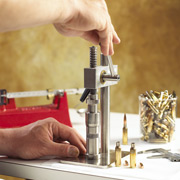 7. Bullet seating
7. Bullet seating
Finally, the bullet is inserted into the neck of the sized, primed and charged cartridge case with the press using a seating die. The overall length of the cartridge must follow the reloading guide instructions to ensure accuracy and to avoid loading problems.
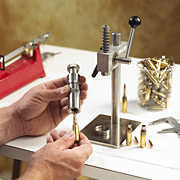 8. Final inspection
8. Final inspection
Inspect the reloaded cartridge and wipe off any remaining case lube. Always visually check your reloaded ammunition to ensure that everything is in order. Gather and file the details (case, primer, powder, bullet, load etc) of the cartridge batch. Pack and mark the cartridges for easy identification, so you know which batch is which even after a storage period.
Disclaimer
As Nammo Lapua Oy / Nammo Vihtavuori Oy has no control over improper storage, handling, loading or use of our powders after they have left the factory, we make no warranty of any kind, either expressed or implied, limited or full. We specifically disclaim all warranties of fitness for a particular purpose and merchantability. We specifically disclaim all liability for consequential damages of any kind whatsoever, whether or not due to seller’s negligence or based on strict product liability or principle of indemnity or contribution, Nammo Lapua Oy / Nammo Vihtavuori Oy neither assumes nor authorizes any person to assume for it any liability in connection with the use of this product.
For even more info, check the newest Vihtavuori Reloading Guide, available as a .pdf in our Material bank.
